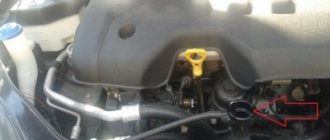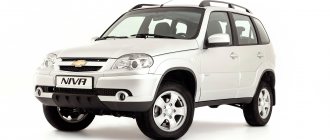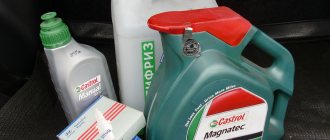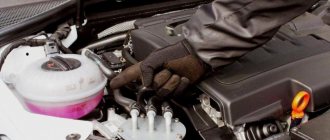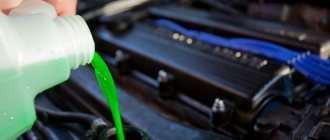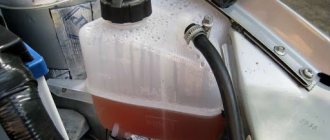Sooner or later, all car enthusiasts have to face one problem - replacing the coolant. In this article we will try to give a detailed answer to the question of what antifreeze to fill in the Hyundai Solaris, in what volume and how to correctly replace the coolant.
The instructions that come with the Hyundai Solaris car say that the first coolant replacement should be carried out no earlier than after 200,000 kilometers. However, for those motorists who rarely use the car, this indicator is determined not in mileage, but in years - and here the indicator is 10 years. Further replacement must be carried out after 30 thousand kilometers or every two years of operation.
Stages of replacing Hyundai Getz coolant
The best option for replacing the coolant is draining the old antifreeze and completely flushing the system with distilled water. This method achieves the optimal ability of the new liquid to remove heat. And also retain its original properties for a longer time.
The car was supplied under different names and modifications for different markets, so the process will be relevant for the following models:
- Hyundai Getz Restyling;
- Hyundai Click;
- Dodge Brisa;
- Inokom Getz;
- Hyundai TB (Hyundai TB “Think Basic”).
Engines of different sizes were installed on this model. The most popular are petrol 1.4 and 1.6 liters. Although there were still options for 1.3 and 1.1 liters, as well as a diesel engine with a volume of 1.5 liters.
Coolant drain
You can find information on the Internet that in order to drain the fluid more completely, you need to replace it on a warm engine. But this is fundamentally wrong; you need to change it only when it has cooled down, at least to 50°C.
When replacing on a hot engine, there is a possibility of deformation of the block head due to a sudden change in temperature. There is also a high risk of getting burns.
Therefore, before starting work, we leave the machine to cool down. During this time, you can complete the preparation. For example, remove protection if it is installed, after which you can proceed to further actions:
- At the bottom of the radiator we find the drain plug, it is red (Fig. 1). We unscrew it with a thick screwdriver, having previously placed a container under this place.
Fig.1 Drain plug - The drain plug on Getz often breaks, so there is another drain option. To do this, you need to remove the lower radiator pipe (Fig. 2).
Fig.2 Hose going to the radiator - We open the caps of the radiator and expansion tank, thereby ensuring the air supply to them. Therefore, the antifreeze will begin to drain more intensely.
- To remove liquid from the expansion tank, you can use a rubber bulb or syringe.
- Since there is no drain plug in the engine, you need to drain the antifreeze from the pipe suitable for it (Fig. 3). For better access to this hose, you can disconnect the wires connected using a male-female connector.
Fig.3 Pipe for draining from the engine
The most difficult task is removing and installing hose clamps without special tools. Therefore, many advise changing them to regular, worm-type ones. But it is better to buy a special puller, which is not expensive. It will save a lot of time when replacing now and in the future.
So on this model you can completely drain the antifreeze as much as possible. But you should understand that some of it will still remain in the block’s channels.
Flushing the cooling system
To flush the cooling system from heavy deposits, special flushes based on chemical components are used. With a normal replacement this is not required, you just need to flush the old antifreeze out of the system. Therefore, we will use ordinary distilled water.
To do this, we put the pipes in their places, clamp them with clamps, and check that the drain holes are closed. We fill the expansion tank to the strip with the letter F, then fill the radiator with water up to the neck. Screw on the caps and start the engine.
You need to wait until the engine warms up to operating temperature. When the thermostat opens, water will flow through a large circuit, flushing the entire system. After this, we turn off the car, wait for it to cool down and drain it.
We repeat these steps several times. A good result is considered when the color of the drained water is transparent.
Filling without air pockets
When using ready-made antifreeze for filling, you need to understand that after flushing, a residue of distilled water that cannot be drained remains in the system. Therefore, for Hyundai Getz it is better to use concentrate and dilute it taking into account this residue. Usually about 1.5 liters remain undrained.
It is necessary to fill in new antifreeze in the same way as distilled water when flushing. First into the expansion tank to mark F, then into the radiator to the top of the neck. In this case, you can press the upper and lower thick pipes going to it with your hands. After filling, tighten the plugs on the filler necks.
We begin warming up, periodically adding gas to speed up the warming up and speed of fluid circulation. After complete warming up, the stove should blow hot air, and both pipes going to the radiator should be evenly heated. This indicates that we did everything correctly and did not develop an air lock.
After warming up, turn off the engine, wait until it cools down and check the level. If necessary, fill the radiator to the top, and in the tank between the letters L and F.
Recommendations
Comments 16
In the technical documents of Hyundai “Engine coolant All models: Coolant based on ethylene glycol for aluminum radiators” And it’s very interesting about the original antifreeze www.drive2.ru/l/4043266/
Affiliate link, thanks! We need to pour G12, no lower...
Is it really possible? G11 needs to be filled in, it seems, and that’s all.
The main topic is Goetz Club Moscow in contact, I’ll also look at what’s written in the book that comes with the car, just soon MOT 90 will replace all fluids, I’ve already got my eye on Equalol green g11
Can I have a link please?
I'm not a chemist, but all cars now have aluminum blocks and radiators, what's the difference?
Moreover, G11/12/13 was invented by VAG and this designation has nothing to do with Hyundai...
The main topic is Goetz Club Moscow in contact, I’ll also look at what’s written in the book that comes with the car, just soon MOT 90 will replace all fluids, I’ve already got my eye on Equalol green g11
G12 and higher have better performance characteristics than g11, you just need to rinse thoroughly before pouring.
Years of production of Hyundai Getz: 2002-2011 (from 2002 to the end of 2005 - Dorestayl; from the end of 2005/beginning of 2006-2011 - Restayl), GL and GLS configurations. Body types: three-door coupe, five-door hatchback.
Gasoline engines 1.1; 1.3; 1.4; 1.6; Diesel: 1.5; Used engines on pre-restayl: petrol 1.1; 1.3; 1.6; diesel 1.5; Restyled engines used: petrol 1.1; 1.4; 1.6; diesel 1.5;
Recommended engine oil: synthetic 5w20; 5w30 (during cold periods/severe frosts: 0w30, 0w40); volume of oil to be filled for the engine 1.1 - 3 l; engines 1.3; 1.4; 1.6 - 3.3 l; for a 1.5 liter diesel engine - 4.8 and 5.3 liters. (depending on the engine modification) Discussions on oils: getz-club.ru/forum/index.…c&showtopic=21810&st=2100 www.autopeople.ru/forum/h…tz/exploitation/8285.html The most popular brands: Mobil, Castrol, Motul, Shell, Hyundai/Kia, Total, Lukoil, etc. Also, see below for links to oil-club.
Automatic transmission oil: Any, special SP3 (Hyundai/Kia, BP, Ravenol, Mitsubishi, ZIC, etc.); System volume: 6.1 l. Discussion: getz-club.ru/forum/index.php?showtopic=25073 Most often, Mitsubishi ATF SP3 or the original Hyundai/Kia ATF SP3 are filled in; other SP3 specification oils are also suitable, for example RAVENOL® MM SP-III Fluid.
Manual transmission oil: API GL-4 (SAE 75W/90); Volume: 2.15 liters Discussion: getz-club.ru/forum/index.php?showtopic=28330 The most popular brands: Mobil, Castrol, Motul, Shell, Hyundai/Kia, etc.
Antifreeze. Color: green, blue; specification G11 (mixing of these colors is allowed); The total volume of the system for a 1.1 engine is 6 liters; Engines 1.3; 1.4 - 6.2 liters; 1.5 - 6.7 liters; 1.6 - 6.5 liters; Discussion: getz-club.ru/forum/index.php?showtopic=32772 The most popular brands: Mobil, Motul, Shell, Hyundai/Kia, Hepu, etc.
Brake fluid: DOT4; The approximate volume of the system is 1 l; The most popular brands: Mobil, Motul, Shell, Hyundai/Kia, Ravenol, Hepu, etc.
Power steering fluid: PSF-III, or ATF; total system volume: 0.8-1 l; The most popular brands: Mobil, Castrol, Motul, Shell, Hyundai/Kia, Gunk, Ravenol, etc.
Wiper blade sizes: driver: 55/60 cm; passenger-35/36 cm; rear: 35-36 cm (mounting type: hook) Discussion of wipers and windshield washer nozzles: getz-club.ru/forum/index.php?showtopic=121 The most popular brands: Denso, Bosch, SWF, Valeo, Hola, Hella, Alca , Champion.
Plugs used in Getz: Original code: 18814-11051 - they are also most often: NGK BKR5ES-11 The same spark plugs are used for all gasoline engines (1.1, 1.3, 1.4, 1.6). The original packaging contains: NGK BKR5ES-11 Champion RC10YC4 Denso K16PR-U11 And other suitable analogues (see catalogs of candle manufacturers) Source: getz-club.ru/forum/index.php?showtopic=2268
Those. standard wheel parameters: 14" 4x100 5J ET46 CO 54 14" 4x100 5.5J ET46 CO 54 15" 4x100 5.5J ET38 CO 54 Discussion of rims: getz-club.ru/forum/index.php?showtopic=42622 getz- club.ru/forum/index.php?showtopic=31452
Tire pressure (front, rear): 2.1-2.3 atm (optimal pressure and factory tire/wheel size are indicated on the driver's threshold)
The standard battery has the following parameters: Capacity: 50Ah (Delkor battery is installed from the factory) Dimensions (WxDxH), mm: 205x170x212 (the platform allows you to accommodate batteries up to 235x170, batteries up to 220mm high can be installed without problems); The polarity is reversed. Recommended capacity when replacing a standard battery with a new one: 50-62 Ah; Starting current: 500-620 A The most popular brands: Varta, Bosch, Medalist, Topla, etc. Discussion: getz-club.ru/forum/index.php?showtopic=11464
Type of fuel to be filled for gasoline. engine: AI-92/95; For diesel: DT (summer/winter). Fuel tank capacity: 45 l
Maintenance frequency: Once every 15,000 km/1 year (under severe operating conditions: 7,500 km/1 year)
Timing for replacing coolant in Hyundai Getz
A pressing issue when replacing coolant in any car is the frequency of this operation. Experts do not identify strict values that should be guided by, but they pay attention to the service life of the antifreeze itself.
Depending on the brand and class of coolant, it is changed approximately every 5 years . The main condition is its high-quality work during this period and the absence of other factors requiring replacement. The reason for changing antifreeze ahead of schedule may be one of the following factors:
- the car was purchased on the secondary market and there is no information about the coolant filled;
- the engine overheats greatly, the antifreeze level constantly drops;
- the coolant has changed its color, foreign impurities, chips, and sediment have appeared in the expansion tank;
- a malfunction of one or more parts of the cooling system has been detected, the replacement of which requires draining the coolant.
If no such reasons are found, the antifreeze in the Hyundai Getz is replaced taking into account the service life of the filled consumable. In a car purchased from the manufacturer, the coolant may not require replacement for up to 9 years.
Main reasons
If the stoves on Hyundai Getz cars do not heat well, potential reasons may lie in:
- cooling system;
- thermostat;
- ventilator;
- cabin filter;
- stove radiator.
Let's look at each problem separately and find ways to solve them.
Cooling system
As with other cars, in the case of the Hyundai Getz there is a rule according to which the heating system is directly dependent on the cooling system. Therefore, if the furnace begins to blow not warm, but cold air, despite the heating mode being set, the reasons should be sought in the cooling system.
It operates in the Hyundai Getz on antifreeze, which can leak out or simply evaporate as the vehicle is used. Some car owners simply forget to periodically add coolant.
If there is a leak due to damage, you will have to check the radiator, pipes and all connections for integrity. The task is more complex, which amateurs in the field of car repair should better entrust to specialists. To begin with, just try adding antifreeze to the tank up to the MAX mark. If the stove returns to normal operation, you have identified the cause.
Thermostat
It is considered a rather complex problem, since the thermostat is responsible for regulating the temperature of the motor. It also controls the flow of coolant that circulates through Hyundai Getz systems.
If the antifreeze does not function well or has failed, then the heated coolant will not be able to enter the heater. Therefore, it will be cold inside the Hyundai Getz cabin.
The problem can only be solved by dismantling and replacing the thermostat.
Fan
If the stove warms up, but the heated air still does not enter the cabin or comes out very weakly, the problem may be with the heater fan. To change the fan yourself, you will need to carry out a number of dismantling works. On the Hyundai Getz, the fan is not hidden so far, but beginners may have some difficulties accessing this element.
You can try to do everything yourself or entrust the work to car service specialists.
Checking the tightness of the cooling system
Wait until the engine has cooled, then carefully remove the radiator cap.
Check the coolant level (should be at the lower edge of the radiator neck).
Install a device for checking the radiator plugs on the radiator neck and create a pressure of 140 kPa (1.4 kgf/cm 2 ) in the system. Maintaining the specified pressure for 2 minutes, make sure that there are no fluid leaks from the system, through hoses and connections.
If there are fluid leaks, repair them or replace faulty parts.
NOTE
The coolant temperature may be very high. Do not open the cooling system when the engine is hot, as this may cause hot fluid to escape, causing burns. Proceed to work on the cooling system only after the engine has cooled down.
Wipe the tested components and connections of the cooling system dry.
When removing the test fixture, be careful not to let any coolant spill out of it.
When installing, checking and removing the test fixture, be careful not to deform the radiator neck.
Timing belt, rollers and pump
In principle, everything has already been described in the section Replacing the timing belt. Replace the timing belt, timing rollers and, preferably, the coolant pump every 60 thousand mileage.
Recommended timing belt replacement interval: every 60 thousand kilometers
List of spare parts for timing belt maintenance
For engines 1.4 (g4ee) and 1.6 (g4ed) -
- Tension roller - 24410-26000;
- Bypass roller - 24810-26020;
- Timing belt - 24312-26001;
- Water pump - 25100-26902;
- Water pump gasket - 25124-26002.
For engine 1.3 (g4ea) -
- Tension roller - 24410-22020;
- Timing belt - 24312-22613;
- Water pump - 25100-22650;
- Water pump gasket - 25124-22000.
Checking the density of the coolant
The cooling system should be filled year-round with a solution of ethylene glycol in water, which prevents damage due to freezing and corrosion, the formation of lime deposits and, in addition, increases the boiling point of the coolant. Due to the expansion of the liquid when heated, excess pressure is created in the cooling system circuit, which also contributes to an increase in the boiling point of the liquid. The pressure is limited by a valve in the expansion tank cap. A higher boiling point of the coolant is necessary for normal operation of the cooling system. If the boiling point is too low, vapor locks may form in the system, which can damage the cooling circuit and reduce engine cooling. Therefore, the cooling system must be filled with antifreeze all year round.
Only ethylene glycol-based antifreeze can be used as a coolant for parts made of aluminum alloys.
NOTE
It is recommended to check the coolant level on a cold engine, since when heated its volume increases and in a warm engine the liquid level can rise significantly.
Remove the radiator cap.
Check the density of the coolant with a hydrometer, which should be 1.078–1.085 g/cm3.
If the level in the tank is below normal and the density of the liquid is higher than specified, add distilled water. If the density is normal, add fluid of the same brand as the fluid in the cooling system. When the density is below normal, restore it with concentrate.
WARNINGS
When the antifreeze concentration is below 30%, the anti-corrosion properties of the coolant are reduced.
At concentrations above 60%, the frost resistance and cooling properties of the liquid are reduced, which negatively affects engine operation. Therefore, it is necessary to maintain the concentration of ethylene glycol within the specified limits.
Do not mix coolants of different brands.
Video
The cooling system is filled year-round with a mixture of water and antifreeze with an anti-corrosion additive from the VW/SEAT concern. This mixture prevents freezing and corrosion of the cooling system, salt deposits and, in addition, increases the boiling point of the coolant. In the circulation circuit, as a result of the expansion of the liquid when heated, increased pressure is created, which also contributes to an increase in the boiling point of the coolant. The pressure is limited by a valve located in the expansion tank cap, which opens at a pressure of 1.4 - 1.6 bar. For the engine cooling system to function flawlessly, a high boiling point of the coolant is required. If the boiling point is too low, vapor locks can form, causing poor engine cooling. Therefore, the cooling system must be filled with a mixture of water and antifreeze all year round.
It is necessary to use antifreeze G12 Plus (purple color, exact designation G 012 A8F) or another con, for example, Glysantin-Alu-Protect-Premium/G30.
If the cooling system is filled with a mixture containing G12 antifreeze (red, exact designation G 012 A8D), then red G12 antifreeze or another con, for example, Glysantin-Alu-Protect/G30, can also be used to replenish the coolant level. Note: G12 purple can be mixed with G12 red.
Caution: Do not mix red G12 antifreeze with the older green G11 antifreeze, as this can cause severe engine damage. The coolant is brown (the result of mixing antifreeze G12 and G11), replace it immediately.
Note:
If a liquid with an antifreeze additive of the wrong specification accidentally ends up in the cooling system, the system must be flushed. To do this, all liquid from the cooling system should be completely drained and the system filled with clean water. Leave the engine idling for two minutes. Drain the water again and blow out the system from the side of the expansion tank with compressed air to completely empty it. Close the drain plug and fill the cooling system with a mixture of water and G12-Plus antifreeze.
Attention: To replenish the cooling system (also in the warm season), only use a mixture of G12-Plus (purple) with soft, clean water. The proportion of antifreeze, also in summer, should not be lower than 40%. Therefore, when refilling the cooling system Antifreeze should always be added to water.
In our latitudes, the coolant should provide protection against freezing down to -25 °C, or even better - down to -35 °C. The proportion of antifreeze should not exceed 60% (antifreeze protection of the coolant down to -40 °C), otherwise the antifreeze protection and cooling effect of the liquid are reduced. Note:
Depending on the equipment of the vehicle, the amount of coolant filled may differ slightly from the values indicated in the table
Ratio of coolant components in liters
Replacing antifreeze on a Hyundai Getz is carried out according to a standard procedure, which requires the car owner to have certain technical knowledge of the cooling system and experience working with the engine. If you have minimal skills, you can change the coolant yourself; the procedure takes up to three hours, depending on the flushing.
Assembly
Insert the O-ring into the groove at the end of the inlet pipe, wet the O-ring with coolant, and attach the inlet pipe to the cylinder block.
Make sure there is a yellow mark on the supply hose and connect the end of the hose with the yellow mark to the end of the supply pipe with the yellow mark.
NOTES
Do not apply oil or grease to the O-ring of the supply line.
The supply line should be inserted all the way into the socket in the cylinder block.
Removed O-rings are not reused and must be replaced with new ones.
Replacement frequency, what antifreeze to fill
Previously, according to the regulations, the first replacement had to be carried out at a mileage of 45,000 kilometers. Subsequent replacements must be made taking into account the antifreeze used. This information must be present on the product canister.
For Hyundai vehicles, it is recommended to use original antifreeze that meets the Hyundai/Kia MS 591-08 specification. It is produced by the Kukdong company in the form of a concentrate called Hyundai Long Life Coolant.
It is best to choose a green canister with a yellow label, this is a modern P-OAT phosphate-carboxylate liquid. Designed for a service life of 10 years, ordering numbers 07100-00220 (2 l.), 07100-00420 (4 l.).
Our more popular antifreeze in a silver canister with a green label has a service life of 2 years and is considered obsolete. It is manufactured using silicate technology, but also has all the approvals, 07100-00200 (2 l.), 07100-00400 (4 l.).
Both antifreezes have the same green color, which, as is known, does not affect the properties, but is used only as a dye. Their chemical composition, additives and technologies are different, so mixing is not recommended.
You can also fill in TECHNOFORM products. This is Crown LLC A-110, which is poured into Hyundai cars at the factory. Or its full analogue Coolstream A-110 produced for retail sale. They are produced in Russia under license from Kukdong and also have all the necessary approvals.
How much antifreeze is in the cooling system, volume table
Leaks and problems
The Hyundai Getz has some weak points. These include the radiator cap; due to the jamming of the valve located in it, there is a possibility of a leak in the system. This occurs due to excess pressure, which the stuck valve ceases to regulate.
The radiator drain plug often breaks and requires replacement; when replacing the fluid, it is better to have it in stock. Order code 25318-38000. Sometimes there are problems with the stove, which can cause the interior to smell like antifreeze.
